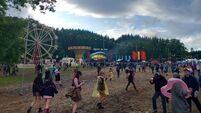Cork In 50 Artworks, No 38: Virgin Shroud, by Dorothy Cross, at Tate Gallery

Dorothy Cross and her dog Connie. Picture: Patrick Cross
Dorothy Cross’s Virgin Shroud is possibly one of the most disquieting artworks ever made. It embodies Sigmund Freud’s idea of the uncanny as ‘unheimlich’, whereby something can be both familiar and unsettling at once, and is a perfect example of what Marcel Duchamp defined as an ‘assisted readymade’, an artwork that combines two objects or articles, often to disturbing effect.
The sculpture comprises a six-and-one-half foot mannequin concealed by two layers of material, the first the train of a silk wedding-dress, the second a cow-hide whose erect teats form what appears to be a crown. On the artist’s instructions, it can only be shown facing away from the viewer, towards the wall.
Virgin Shroud dates from 1993 and is one of a series of works that Cross made around that time from cow-hides and udders. It is now in the Tate Collection in London.

Cross traces her Cow series back to an experience she had while working on a public art project in Norway in the 1980s. “I visited a museum, where I came across a sieve made out of a cow’s udder. The sieve was like a bodhrán. There was something really wonderful and tragic and surreal about it, and it was such a fantastic use for a part of the cow that is usually discarded.
"When I came back to Ireland I was transfixed by the power of what I'd seen; the vulnerability of the sieve and also the sheer Norwegian practicality of adapting it from a cow’s udder. But I could also see the potential; there was this mixture of shock and a kind of endearment because you were dealing with such a vulnerable part of the animal, but a part that’s crucial to the production of milk and cheese and everything else.”
Cross, a native of Montenotte in Cork who’d studied at the Crawford Municipal School of Art, Leicester Polytechnic in the UK, and the San Francisco Art Institute in California, was living in Dublin at the time. She began looking for cow-hides and udders she could work with at her studio in the Pigeon House power station in Dublin Bay. She realised the cows would have to be skinned upside down, as their carcasses are usually cut down the belly, a process that damages their udders.
“At that time, there were still these small abattoirs around the country, and this one guy agreed to supply me. The hides cost me £100 each, and I had very little money in those days, so I could only afford one at a time. They were kind of ghastly when they arrived. I used to tell people I felt like a cross between a butcher and a plastic surgeon. The skins would come in wet and cleaned but I would have to dry them over forms.”
Virgin Shroud was, she remembers, the second or third work she made from the cowhides. “She – I always think of these sculptures as female – came out of reading a book by Marina Warner called Alone of All Her Sex, which is all about the cult of the Virgin Mary and the endorsement of the mammary in terms of motherhood and everything else."
When Cross draped one of the hides teats-up over an armature, she had a moment of revelation. “I realised I’d created this horned crown, and the skin was like drapery falling away from it. The cow had not been treated well, she had tears in her skin, and I stitched them together with wax threads. I then had the piece sitting in my studio for a long time before deciding I should counterpoint it with something more seductive and beautiful.
"I had the silk train from my grandmother Delia’s wedding dress laying around; she gave it to me when I was fourteen to make a blouse. But now I draped it inside the cow skin, and somehow the softness and beauty and iridescence of it was a counterpoint to the barbarity of the skin.”
Virgin Shroud was first shown at the Tate in London. “She was behind a little rope, which I hated, and the silk train wasn’t lying on the ground properly. I wanted to go in and sort it out, but there were guards everywhere, and I would have been arrested if I had. But I called up the curator and asked if I could do some tweaking, and they were okay with that. The Tate bought the work; I got very little money, but it was brilliant that it went in their collection.”
Cross could not have predicted how iconic a piece Virgin Shroud would become. “With the Cow sculptures, more than anything else I’ve done, I knew they were disturbing. I was never one of these shock in-your-face artists, but you can never predict the effect your work will have. I always wanted to try and balance things out, so there's a possibility of people being able to approach the work without fear or horror and engage with it. I’d hope people can relate to Virgin Shroud with curiosity and possibly a small element of disgust, but also intrigue.”
She believes part of the work’s impact can be attributed to its height. “She has this monumentality, this power. She always stands against the wall, so you only ever see her from the back, which again is slightly iconoclastic. And the title was terribly important. Virgin Shroud: the virginity implies purity and potential, while the shroud refers to death.”

Cross made about 20 works from cowhides and udders in all, including Amazon, Saddle and Stiletto. “It was like a surge of energy, I almost didn’t have to think when I was making those pieces. I found out afterwards that the Pigeon House had been designed by an architect who was famous for building abattoirs. Isn’t that weird?”
In 1993, Cross had a show called Bad Girls at the Institute of Contemporary Arts in London, where her work came to the attention of Charles Saatchi, the legendary advertising mogul and collector who is credited with kickstarting the careers of artists such as Damien Hirst, Tracey Emin and Jenny Seville.
“Saatchi wanted to buy three of my pieces, but at a quarter of the price I was asking for them. People said, you shouldn’t say no to Saatchi, but how dare he offer me a quarter of the price, you know?”
Cross could have continued making Cow sculptures for years, but she has never been keen on repeating herself. “One night I dreamed I was in Macy’s Department Store in New York City; I walked in and everything was covered in cows’ teats. And I said, no, no! Enough! And that was it.”
Cross has gone on to become one of Ireland’s most venerable artists, working with materials as diverse as dead sharks and gannets, wooden currachs and a desiccated human heart. Her public artworks have included Ghost Ship in Dublin Bay, Stabat Mater in Valentia stone quarry and Heart Ship in Cork.
Now resident in Killary Harbour, in Connemara, she is working towards her next solo exhibition at Frith St, London, called Damascus Rose, which opens on February 16 and runs until Easter.
- dorothycross.com
- frithstreetgallery.com
- tate.org.uk/art/artists/dorothy-cross-2357/dorothy-cross-virgin-shroud







